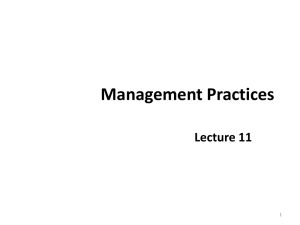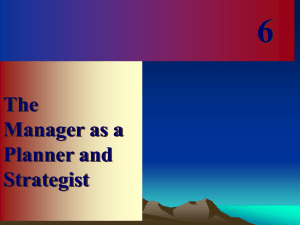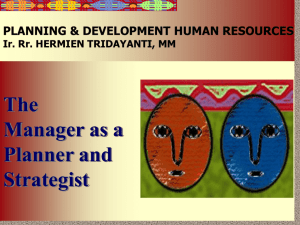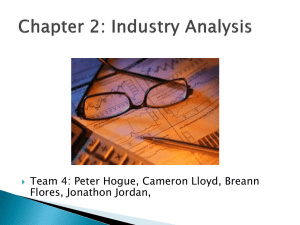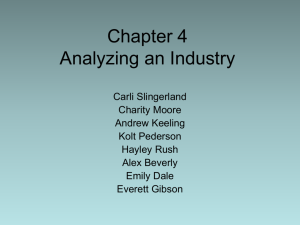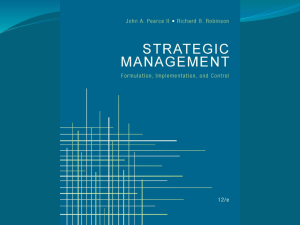File
advertisement
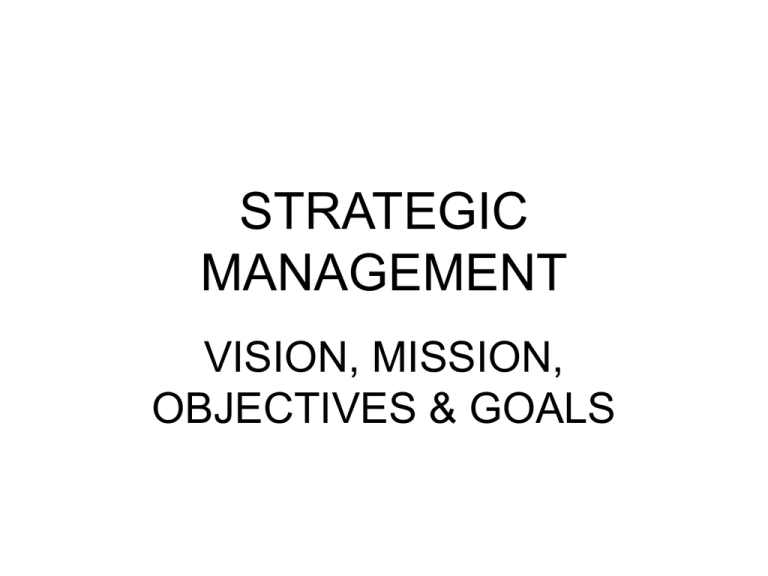
STRATEGIC MANAGEMENT VISION, MISSION, OBJECTIVES & GOALS VISION • Core ideology • Envisioned future • Specific • Interest of shareholders • Communicated to all MISSION It is an enduring statement of purpose that distinguishes one business from other similar firms. Features • Clarity • Broad & enduring • Identity & image • Realistic • Specific • Values, beliefs & philosophies • Expression of vision Strategic Planning Strategy: A process that results in an outcome, which is the basis for organizational decisions and actions. Strategic Thinking: determination of basic long-term goals and objectives of an enterprise , adoption of courses of action. Strategic planning is a process that involves the review of market conditions; customer needs; competitive strengths and weaknesses; sociopolitical; legal; and economic conditions; technological developments; and the availability of resources that lead to the specific opportunities or threats ffacing the organization Strategic Planning involves taking information from the environment and deciding upon an organizational mission and upon objectives, strategies, and a strategic architecture. Important in the highly competitive and global economy. Uncertainty, instability and changing environment rule rather than an exception. Strategic Management • Set of decisions and actions used to implement strategies that will provide a competitively superior fit between the organization and its environment so as to achieve organizational goals Strategic Management Managers ask such questions as... What changes and trends are occurring? Who are our customers? What products or services should we offer? How can we offer these products or services most efficiently? Purpose of Strategy • The plan of action that prescribes resource allocation and other activities for dealing with the environment, achieving a competitive advantage, that help the organization attain its goals Strategies focus on: ● Core competencies ● Developing synergy Three Levels of Strategy in Organizations Corporate-Level Strategy: What business are we in? Corporation Business-Level Strategy: How do we compete? Textiles Unit Chemicals Unit Auto Parts Unit Functional-Level Strategy: How do we support the business-level strategy? Finance R&D Manufacturing Marketing Strategic Management Process Scan External Environment – National, Global Evaluate Current Mission, Goals, Strategies Scan Internal Environment – Core Competence, Synergy, Value Creation Identify Strategic Factors – Opportunities, Threats SWOT Define new Mission Goals, Grand Strategy Identify Strategic Factors – Strengths, Weaknesses Formulate Strategy – Corporate, Business, Functional Implement Strategy via Changes in: Leadership culture, Structure, HR, Information & control systems Checklist for Analyzing Organizational Strengths and Management and Organization Marketing WeaknessesHuman Resources Management quality Staff quality Distribution channels Market share Employee experience, education Degree of centralization Advertising efficiency Union status Organization charts Customer satisfaction Turnover, absenteeism Planning, information, control systems Product quality Service reputation Work satisfaction Grievances Sales force turnover Finance Profit margin Production Research and Development Basic applied research Debt-equity ratio Plant location Machinery obsolescence Inventory ratio Purchasing system Return on investment Quality control Laboratory capabilities Research programs New-product innovations Credit rating Productivity/efficiency Technology innovations BCG matrix • Boston Consulting Group matrix evaluates strategic business units with regard to the firms growth rate and market share • Strategic Business Units: divisions within the organization by product or service to establish goals and objectives that are in harmony with the firms overall mission and to assign responsibility for profits and losses Portfolio Strategy • Mix of business units and product lines that fit together in a logical way to provide synergy and competitive advantage BCG Matrix Five Forces Affecting Industry Competition •Internet reduces barriers to entry Potential New Entrants Internet blurs differences among competitors in an industry Threat of Substitute Products •Internet expands market size, but creates new substitution threats •Internet tends to increase the bargaining power of suppliers Bargaining Power of Buyers Rivalry among Competitors •Internet shifts greater power to end consumers Bargaining Power of Suppliers The Five Forces 1. Level of Rivalry in an industry: how intense is the current competition with competitors? Increased competition results in lower profits. 2. Potential for entry: how easy is it for new firms to enter the industry? Easy entry leads to lower prices and profits. 3. Power of Suppliers: If there are only a few suppliers of important items, supply costs rise. 4. Power of Buyers: If there are only a few, large buyers, they can bargain down prices. 5. Substitutes: More available substitutes tend to drive down prices and profits. Porters value chain • Value chain is all the activities an organization undertakes to create value for a customer Primary activities: • – – – – – • Inbound Logistics - involve relationships with suppliers and include all the activities required to receive, store, and disseminate inputs. Operations - are all the activities required to transform inputs into outputs (products and services). Outbound Logistics - include all the activities required to collect, store, and distribute the output. Marketing and Sales - activities inform buyers about products and services, induce buyers to purchase them, and facilitate their purchase. Service - includes all the activities required to keep the product or service working effectively for the buyer after it is sold and delivered. Secondary activities are: – – – – Procurement - is the acquisition of inputs, or resources, for the firm. Human Resource management - consists of all activities involved in recruiting, hiring, training, developing, compensating and (if necessary) dismissing or laying off personnel. Technological Development - pertains to the equipment, hardware, software, procedures and technical knowledge brought to bear in the firm's transformation of inputs into outputs. Infrastructure - serves the company's needs and ties its various parts together, it consists of functions or departments such as accounting, legal, finance, planning, public affairs, government relations, quality assurance and general management. Competitive Edge Through Competitive Strategies • Differentiation = attempt to distinguish products or services from that of competitors • Cost leadership = aggressively seeks efficient facilities, pursues cost reductions, and uses tight cost controls to produce products more efficiently than competitors • Focus = concentrates on a specific regional market or buyer group Tools for Putting Strategy into Action Environment Organization Leadership Persuasion Motivation Culture/values Strategy Structural Design Organization Chart Teams Centralization Decentralization, Facilities, task design Human Resources Recruitment/selection Transfers/promotions Training Layoffs/recalls Information and Control Systems Pay, reward system Budget allocations Information systems Rules/procedures Performance Number of market segments Business-level Strategies Many Low-Cost Differentiation Few Focused Low-Cost Focused Differentiated Low Cost Differentiation Strategy Business Strategies – Low-cost: gain a competitive advantage by driving down organizational costs. • • – Differentiation: gain a competitive advantage by making your products different from competitors. • • – Managers manufacture at lower cost, reduce waste. Lower costs than competition mean lower prices. Differentiation must be valued by the customer. Successful differentiation allows you to charge more for a product. Stuck in the middle: It is difficult to simultaneously become differentiated and low Business Strategies • Firms also choose to serve the entire market or focus on a few segments. – Focused low-cost: try to serve one segment of the market but be the lowest cost in that segment. • – Cott Company seeks to achieve this in large retail chains. Focused differentiated: Firm again seeks to focus on one market segment but is the most differentiated in that segment. • BMW provides a good example. Functional-level Strategies • Seeks to have each department add value to a good or service. • Marketing, service, production all add value to a good or service. – Value is added in two ways: 1. lower the operational costs of providing the value in products. 2. add new value to the product by differentiating. – Functional strategies must fit with business level strategies. Goals for successful functional strategies: 1. Attain superior efficiency: the measure of outputs for a given unit of input. 2. Attain superior quality: products that reliably do the job they were designed for. 3. Attain superior innovation: new, novel features about the product or process. 4. Attain superior responsiveness to customers: Know the customer needs and fill them.
